Occupational Health and Safety: Risk Assessment and Management Report
VerifiedAdded on 2020/02/18
|11
|2200
|517
Report
AI Summary
This report delves into the crucial aspects of occupational health and safety, focusing on the identification, assessment, and management of workplace hazards. The report examines two specific scenarios: the risks associated with chemical exposure in a surfboard manufacturing factory and the impact of noise pollution on workers in an aircraft maintenance workshop. It explores the use of control hierarchies, regulations, and codes of practice to mitigate risks, including the substitution of hazardous materials and the implementation of protective measures. The report also includes a risk assessment matrix to compare the severity and likelihood of incidents with and without control measures, such as the use of ear muffs. The analysis highlights the importance of proactive strategies, technological interventions, and employee training to ensure a safe and healthy work environment. The report concludes by emphasizing the need for continuous improvement and adherence to safety protocols to prevent occupational health issues.

Running head: OCCUPATIONAL HEALTH AND SAFETY
Occupational health and Safety
Name of the student
University name
Authors’ note
Occupational health and Safety
Name of the student
University name
Authors’ note
Paraphrase This Document
Need a fresh take? Get an instant paraphrase of this document with our AI Paraphraser
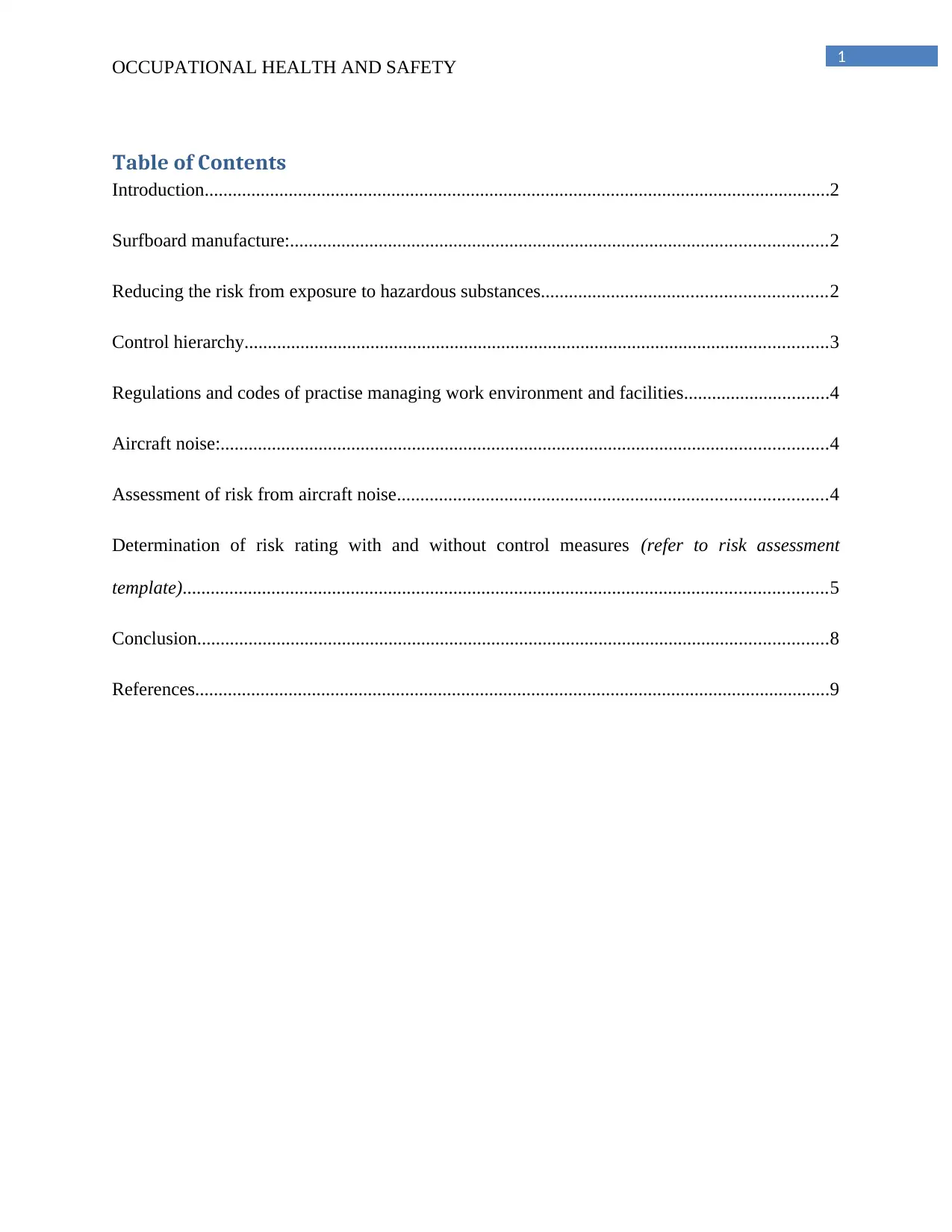
1
OCCUPATIONAL HEALTH AND SAFETY
Table of Contents
Introduction......................................................................................................................................2
Surfboard manufacture:...................................................................................................................2
Reducing the risk from exposure to hazardous substances.............................................................2
Control hierarchy.............................................................................................................................3
Regulations and codes of practise managing work environment and facilities...............................4
Aircraft noise:..................................................................................................................................4
Assessment of risk from aircraft noise............................................................................................4
Determination of risk rating with and without control measures (refer to risk assessment
template)..........................................................................................................................................5
Conclusion.......................................................................................................................................8
References........................................................................................................................................9
OCCUPATIONAL HEALTH AND SAFETY
Table of Contents
Introduction......................................................................................................................................2
Surfboard manufacture:...................................................................................................................2
Reducing the risk from exposure to hazardous substances.............................................................2
Control hierarchy.............................................................................................................................3
Regulations and codes of practise managing work environment and facilities...............................4
Aircraft noise:..................................................................................................................................4
Assessment of risk from aircraft noise............................................................................................4
Determination of risk rating with and without control measures (refer to risk assessment
template)..........................................................................................................................................5
Conclusion.......................................................................................................................................8
References........................................................................................................................................9

2
OCCUPATIONAL HEALTH AND SAFETY
Introduction
The current assignment focuses on the concept of occupational health and safety. The
safety concerns of the employees working within an organization are pivotal to maintaining the
organizational culture. In this context, the risks could be divided into a number of types such as
chemical, biological, psychological and environmental hazards.
The current study focuses on assessment and risk management through implementation
of effective regulations and codes or practise. The assignment takes into consideration two
different scenarios such as hazard due to exposure to different chemical substances and impact of
noise pollution on the health of the workforce.
Surfboard manufacture:
Reducing the risk from exposure to hazardous substances
A number of preventive measures need to be employed for ensuring the health and safety
concerns of the employees working within an organization. As commented by Rothmore and
Boucaut (2015), healthy employees help in enhancing the productivity of the organization. For
the present assignment, the hazards associated with employee health management within a
surfboard factory had been taken into consideration. The manufacturing of the surfboard exposes
the workers to a wide range of hazardous chemicals such as fibreglass, resins, solvents and
paints. Though, the manufacturing unit had provided the workers with additional preventive
measures such as plastic goggles and face masks the staff was still sceptical. The same could be
attributed to the absence of sufficient number of trained staffs within the factory outlet.
OCCUPATIONAL HEALTH AND SAFETY
Introduction
The current assignment focuses on the concept of occupational health and safety. The
safety concerns of the employees working within an organization are pivotal to maintaining the
organizational culture. In this context, the risks could be divided into a number of types such as
chemical, biological, psychological and environmental hazards.
The current study focuses on assessment and risk management through implementation
of effective regulations and codes or practise. The assignment takes into consideration two
different scenarios such as hazard due to exposure to different chemical substances and impact of
noise pollution on the health of the workforce.
Surfboard manufacture:
Reducing the risk from exposure to hazardous substances
A number of preventive measures need to be employed for ensuring the health and safety
concerns of the employees working within an organization. As commented by Rothmore and
Boucaut (2015), healthy employees help in enhancing the productivity of the organization. For
the present assignment, the hazards associated with employee health management within a
surfboard factory had been taken into consideration. The manufacturing of the surfboard exposes
the workers to a wide range of hazardous chemicals such as fibreglass, resins, solvents and
paints. Though, the manufacturing unit had provided the workers with additional preventive
measures such as plastic goggles and face masks the staff was still sceptical. The same could be
attributed to the absence of sufficient number of trained staffs within the factory outlet.
⊘ This is a preview!⊘
Do you want full access?
Subscribe today to unlock all pages.

Trusted by 1+ million students worldwide
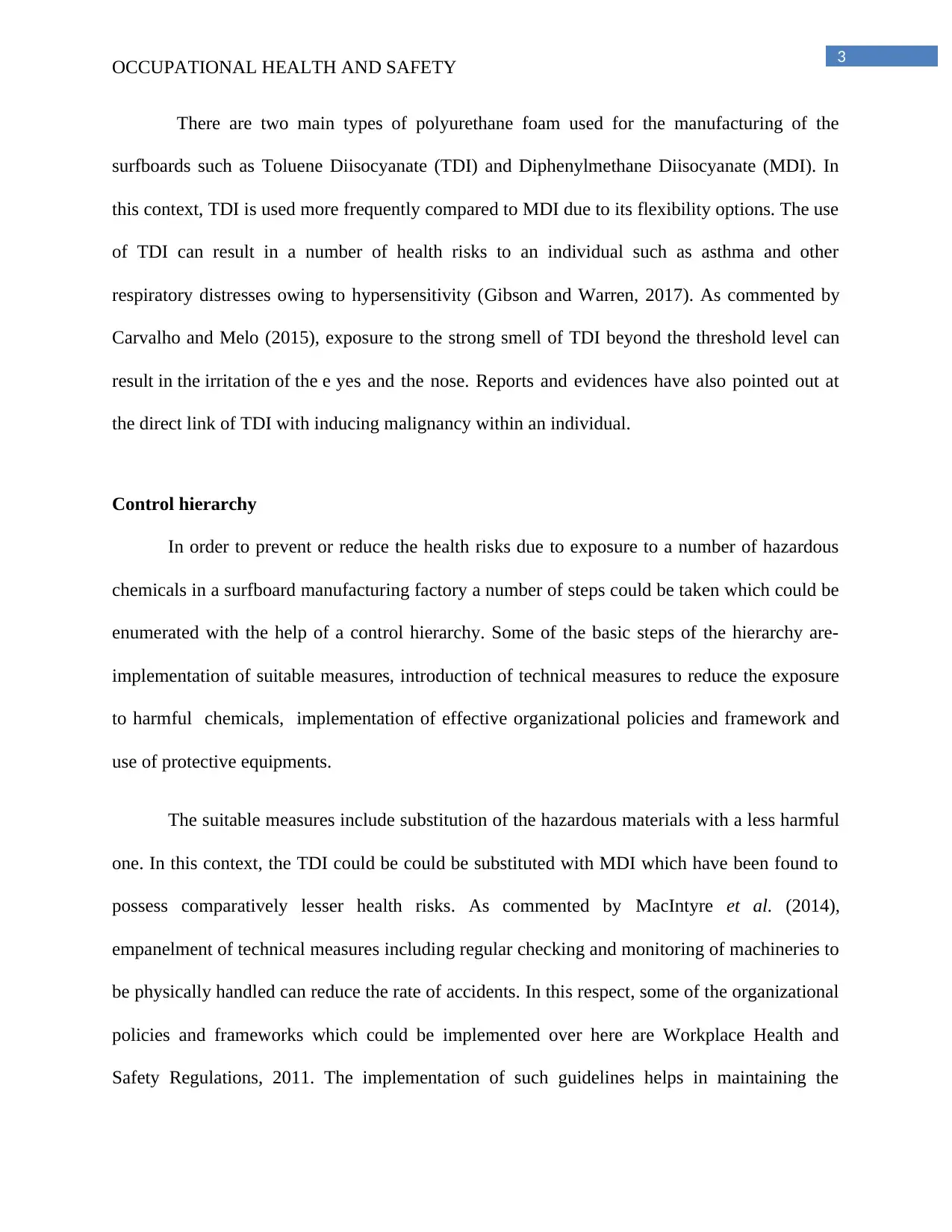
3
OCCUPATIONAL HEALTH AND SAFETY
There are two main types of polyurethane foam used for the manufacturing of the
surfboards such as Toluene Diisocyanate (TDI) and Diphenylmethane Diisocyanate (MDI). In
this context, TDI is used more frequently compared to MDI due to its flexibility options. The use
of TDI can result in a number of health risks to an individual such as asthma and other
respiratory distresses owing to hypersensitivity (Gibson and Warren, 2017). As commented by
Carvalho and Melo (2015), exposure to the strong smell of TDI beyond the threshold level can
result in the irritation of the e yes and the nose. Reports and evidences have also pointed out at
the direct link of TDI with inducing malignancy within an individual.
Control hierarchy
In order to prevent or reduce the health risks due to exposure to a number of hazardous
chemicals in a surfboard manufacturing factory a number of steps could be taken which could be
enumerated with the help of a control hierarchy. Some of the basic steps of the hierarchy are-
implementation of suitable measures, introduction of technical measures to reduce the exposure
to harmful chemicals, implementation of effective organizational policies and framework and
use of protective equipments.
The suitable measures include substitution of the hazardous materials with a less harmful
one. In this context, the TDI could be could be substituted with MDI which have been found to
possess comparatively lesser health risks. As commented by MacIntyre et al. (2014),
empanelment of technical measures including regular checking and monitoring of machineries to
be physically handled can reduce the rate of accidents. In this respect, some of the organizational
policies and frameworks which could be implemented over here are Workplace Health and
Safety Regulations, 2011. The implementation of such guidelines helps in maintaining the
OCCUPATIONAL HEALTH AND SAFETY
There are two main types of polyurethane foam used for the manufacturing of the
surfboards such as Toluene Diisocyanate (TDI) and Diphenylmethane Diisocyanate (MDI). In
this context, TDI is used more frequently compared to MDI due to its flexibility options. The use
of TDI can result in a number of health risks to an individual such as asthma and other
respiratory distresses owing to hypersensitivity (Gibson and Warren, 2017). As commented by
Carvalho and Melo (2015), exposure to the strong smell of TDI beyond the threshold level can
result in the irritation of the e yes and the nose. Reports and evidences have also pointed out at
the direct link of TDI with inducing malignancy within an individual.
Control hierarchy
In order to prevent or reduce the health risks due to exposure to a number of hazardous
chemicals in a surfboard manufacturing factory a number of steps could be taken which could be
enumerated with the help of a control hierarchy. Some of the basic steps of the hierarchy are-
implementation of suitable measures, introduction of technical measures to reduce the exposure
to harmful chemicals, implementation of effective organizational policies and framework and
use of protective equipments.
The suitable measures include substitution of the hazardous materials with a less harmful
one. In this context, the TDI could be could be substituted with MDI which have been found to
possess comparatively lesser health risks. As commented by MacIntyre et al. (2014),
empanelment of technical measures including regular checking and monitoring of machineries to
be physically handled can reduce the rate of accidents. In this respect, some of the organizational
policies and frameworks which could be implemented over here are Workplace Health and
Safety Regulations, 2011. The implementation of such guidelines helps in maintaining the
Paraphrase This Document
Need a fresh take? Get an instant paraphrase of this document with our AI Paraphraser

4
OCCUPATIONAL HEALTH AND SAFETY
organizational culture by promulgating training process of the employees along with provision of
protective equipments.
Regulations and codes of practise managing work environment and facilities
The rules and regulations implemented in the context of a workplace play a crucial role in
ensuring the optimum management of the work environment. Most of the policy and frameworks
are covered under the act of Workplace Health and Safety, 2011. The implementation of the
Construction Work Codes of practise provides a number of safety guidelines for ensuring
health and safety of the workers engaged in the manufacturing process of the surfboards
(safeworkaustralia, 2017). As commented by Cooklin et al. (2015), conducting performance
checks and maintenance of hand equipments can reduce the risk of untoward incidents within a
manufacturing setup.
Aircraft noise:
Assessment of risk from aircraft noise
The second section of the assignment focuses on the control measures of noise pollution
and its adverse effects on the health of an individual. In this context, the problems faced by the
workforce and apprentices of the aircraft maintenance have been highlighted over here. The
noise inside the workshop regularly exceeds 85 decibels, whereas on the runway the noise level
can exceed 140 decibels and above. The exposure to high levels of aircraft noises can generate a
huge number of responses within an individual. Some of the adverse effects are sleep
disturbance, annoyance, learning impairments in children as short term outcomes(Basner et al.
2014). On the contrary, some of the long term effects include high blood pressure, heart attack,
OCCUPATIONAL HEALTH AND SAFETY
organizational culture by promulgating training process of the employees along with provision of
protective equipments.
Regulations and codes of practise managing work environment and facilities
The rules and regulations implemented in the context of a workplace play a crucial role in
ensuring the optimum management of the work environment. Most of the policy and frameworks
are covered under the act of Workplace Health and Safety, 2011. The implementation of the
Construction Work Codes of practise provides a number of safety guidelines for ensuring
health and safety of the workers engaged in the manufacturing process of the surfboards
(safeworkaustralia, 2017). As commented by Cooklin et al. (2015), conducting performance
checks and maintenance of hand equipments can reduce the risk of untoward incidents within a
manufacturing setup.
Aircraft noise:
Assessment of risk from aircraft noise
The second section of the assignment focuses on the control measures of noise pollution
and its adverse effects on the health of an individual. In this context, the problems faced by the
workforce and apprentices of the aircraft maintenance have been highlighted over here. The
noise inside the workshop regularly exceeds 85 decibels, whereas on the runway the noise level
can exceed 140 decibels and above. The exposure to high levels of aircraft noises can generate a
huge number of responses within an individual. Some of the adverse effects are sleep
disturbance, annoyance, learning impairments in children as short term outcomes(Basner et al.
2014). On the contrary, some of the long term effects include high blood pressure, heart attack,

5
OCCUPATIONAL HEALTH AND SAFETY
stroke, which might have much serious consequences. As mentioned by Warner and Hadley
(2015), the Occupational Health and Safety Administration (OSHA) limit for industrial noise is
set at 90 decibel. Therefore, crossing limits equivalent to 140 decibel can cause severe pain
within the individual often causing Tinnitus. The tinnituses are high frequency whistling sounds
or buzzing sounds in the ear or the hippocampus of the brain (Orford et al. 2014). Thus, such
uncomfortable conditions might further develop into hearing losses within individuals.
Determination of risk rating with and without control measures (refer to attached risk
assessment template)
Without ear muffs:
likelihood
severity
Rare (1) Remote (2) Occasional
(3)
Frequent (4) Almost
certain (5)
Catastrophic
(5)
6 8 10 10 23
Major (4) 8 12 14 16 24
Moderate (3) 7 11 13 15 20
Minor (2) 3 6 7 15 18
Negligible (1) 1 1 2 4 5
Table 1: Risk assessment matrix
(Source: researcher)
RPN Risk level
1-3 Low
OCCUPATIONAL HEALTH AND SAFETY
stroke, which might have much serious consequences. As mentioned by Warner and Hadley
(2015), the Occupational Health and Safety Administration (OSHA) limit for industrial noise is
set at 90 decibel. Therefore, crossing limits equivalent to 140 decibel can cause severe pain
within the individual often causing Tinnitus. The tinnituses are high frequency whistling sounds
or buzzing sounds in the ear or the hippocampus of the brain (Orford et al. 2014). Thus, such
uncomfortable conditions might further develop into hearing losses within individuals.
Determination of risk rating with and without control measures (refer to attached risk
assessment template)
Without ear muffs:
likelihood
severity
Rare (1) Remote (2) Occasional
(3)
Frequent (4) Almost
certain (5)
Catastrophic
(5)
6 8 10 10 23
Major (4) 8 12 14 16 24
Moderate (3) 7 11 13 15 20
Minor (2) 3 6 7 15 18
Negligible (1) 1 1 2 4 5
Table 1: Risk assessment matrix
(Source: researcher)
RPN Risk level
1-3 Low
⊘ This is a preview!⊘
Do you want full access?
Subscribe today to unlock all pages.

Trusted by 1+ million students worldwide
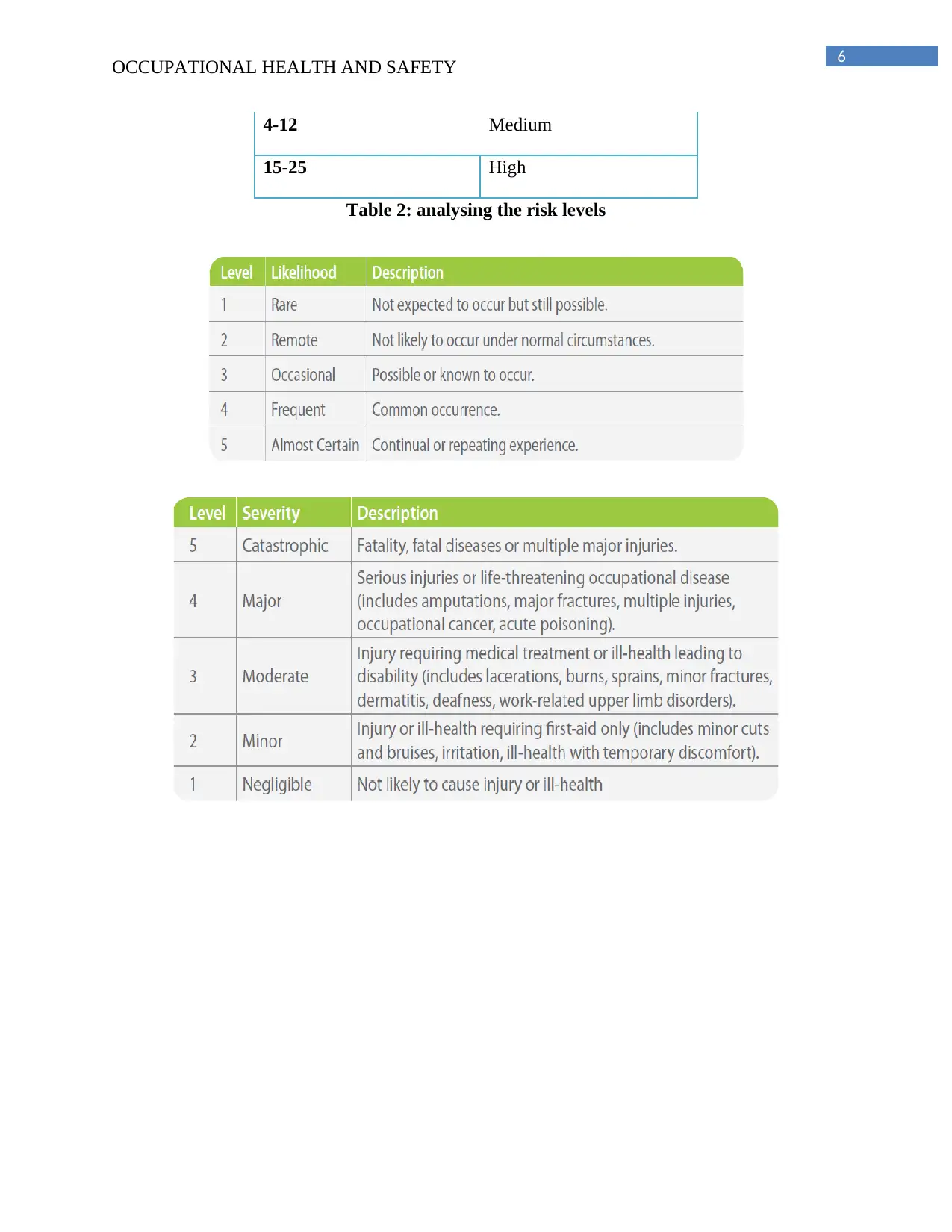
6
OCCUPATIONAL HEALTH AND SAFETY
4-12 Medium
15-25 High
Table 2: analysing the risk levels
OCCUPATIONAL HEALTH AND SAFETY
4-12 Medium
15-25 High
Table 2: analysing the risk levels
Paraphrase This Document
Need a fresh take? Get an instant paraphrase of this document with our AI Paraphraser
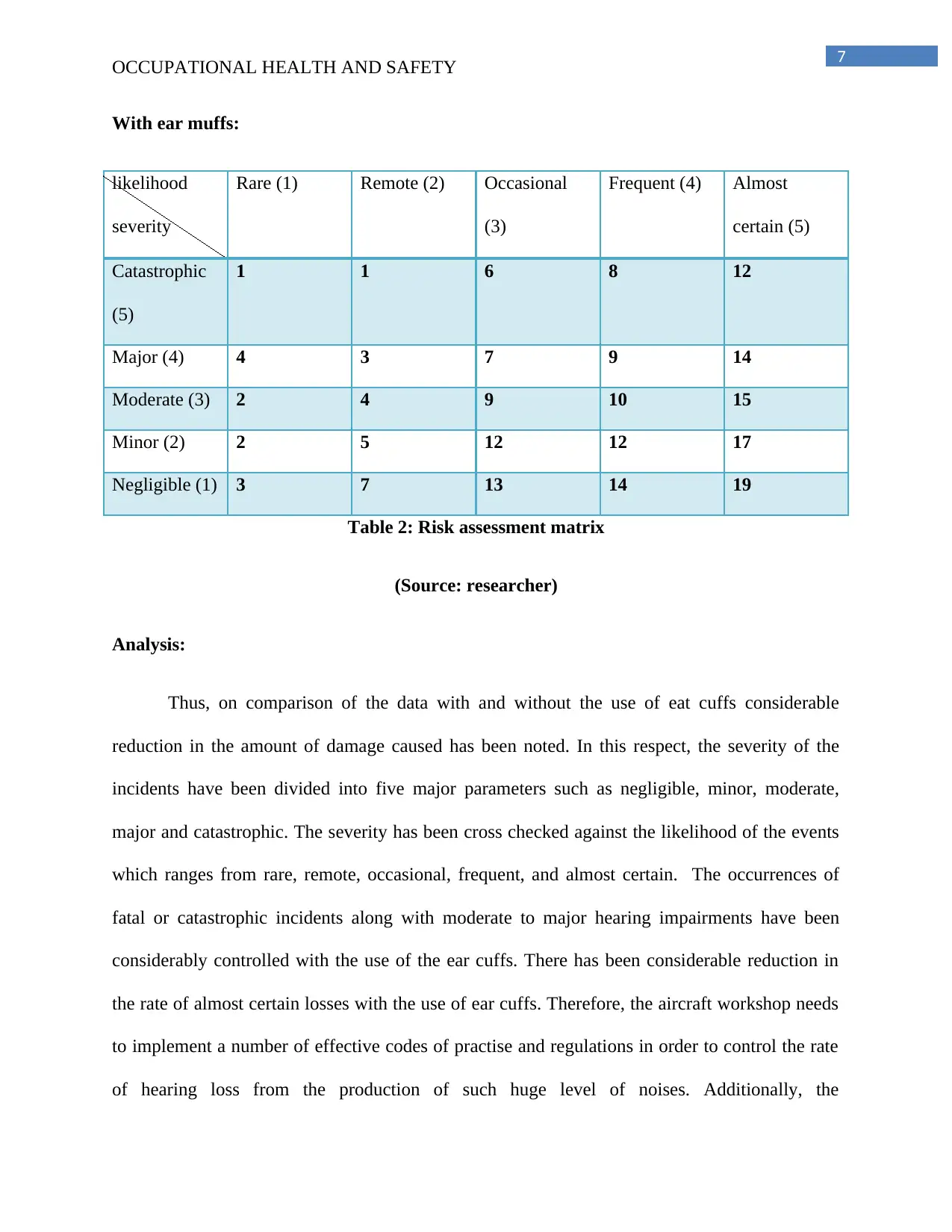
7
OCCUPATIONAL HEALTH AND SAFETY
With ear muffs:
likelihood
severity
Rare (1) Remote (2) Occasional
(3)
Frequent (4) Almost
certain (5)
Catastrophic
(5)
1 1 6 8 12
Major (4) 4 3 7 9 14
Moderate (3) 2 4 9 10 15
Minor (2) 2 5 12 12 17
Negligible (1) 3 7 13 14 19
Table 2: Risk assessment matrix
(Source: researcher)
Analysis:
Thus, on comparison of the data with and without the use of eat cuffs considerable
reduction in the amount of damage caused has been noted. In this respect, the severity of the
incidents have been divided into five major parameters such as negligible, minor, moderate,
major and catastrophic. The severity has been cross checked against the likelihood of the events
which ranges from rare, remote, occasional, frequent, and almost certain. The occurrences of
fatal or catastrophic incidents along with moderate to major hearing impairments have been
considerably controlled with the use of the ear cuffs. There has been considerable reduction in
the rate of almost certain losses with the use of ear cuffs. Therefore, the aircraft workshop needs
to implement a number of effective codes of practise and regulations in order to control the rate
of hearing loss from the production of such huge level of noises. Additionally, the
OCCUPATIONAL HEALTH AND SAFETY
With ear muffs:
likelihood
severity
Rare (1) Remote (2) Occasional
(3)
Frequent (4) Almost
certain (5)
Catastrophic
(5)
1 1 6 8 12
Major (4) 4 3 7 9 14
Moderate (3) 2 4 9 10 15
Minor (2) 2 5 12 12 17
Negligible (1) 3 7 13 14 19
Table 2: Risk assessment matrix
(Source: researcher)
Analysis:
Thus, on comparison of the data with and without the use of eat cuffs considerable
reduction in the amount of damage caused has been noted. In this respect, the severity of the
incidents have been divided into five major parameters such as negligible, minor, moderate,
major and catastrophic. The severity has been cross checked against the likelihood of the events
which ranges from rare, remote, occasional, frequent, and almost certain. The occurrences of
fatal or catastrophic incidents along with moderate to major hearing impairments have been
considerably controlled with the use of the ear cuffs. There has been considerable reduction in
the rate of almost certain losses with the use of ear cuffs. Therefore, the aircraft workshop needs
to implement a number of effective codes of practise and regulations in order to control the rate
of hearing loss from the production of such huge level of noises. Additionally, the
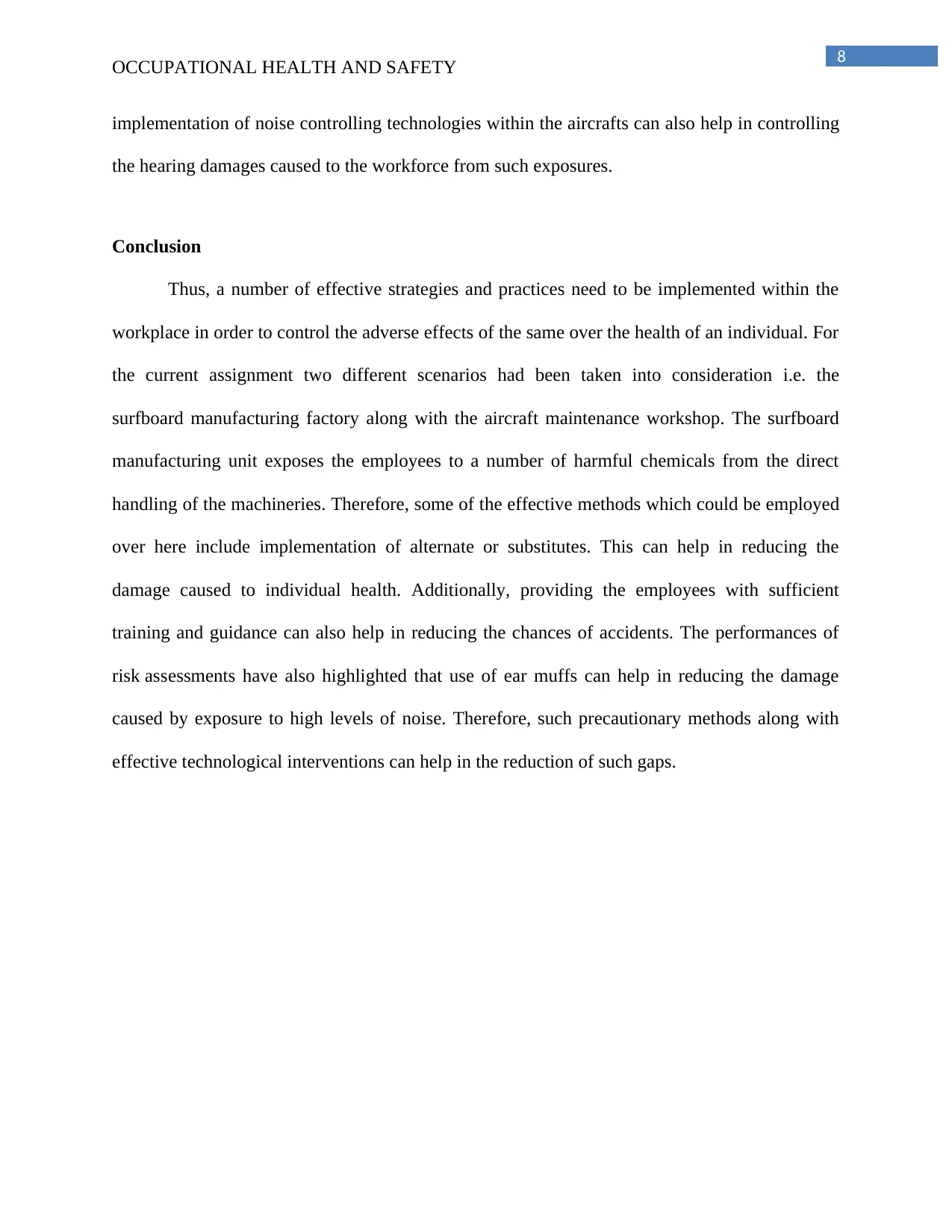
8
OCCUPATIONAL HEALTH AND SAFETY
implementation of noise controlling technologies within the aircrafts can also help in controlling
the hearing damages caused to the workforce from such exposures.
Conclusion
Thus, a number of effective strategies and practices need to be implemented within the
workplace in order to control the adverse effects of the same over the health of an individual. For
the current assignment two different scenarios had been taken into consideration i.e. the
surfboard manufacturing factory along with the aircraft maintenance workshop. The surfboard
manufacturing unit exposes the employees to a number of harmful chemicals from the direct
handling of the machineries. Therefore, some of the effective methods which could be employed
over here include implementation of alternate or substitutes. This can help in reducing the
damage caused to individual health. Additionally, providing the employees with sufficient
training and guidance can also help in reducing the chances of accidents. The performances of
risk assessments have also highlighted that use of ear muffs can help in reducing the damage
caused by exposure to high levels of noise. Therefore, such precautionary methods along with
effective technological interventions can help in the reduction of such gaps.
OCCUPATIONAL HEALTH AND SAFETY
implementation of noise controlling technologies within the aircrafts can also help in controlling
the hearing damages caused to the workforce from such exposures.
Conclusion
Thus, a number of effective strategies and practices need to be implemented within the
workplace in order to control the adverse effects of the same over the health of an individual. For
the current assignment two different scenarios had been taken into consideration i.e. the
surfboard manufacturing factory along with the aircraft maintenance workshop. The surfboard
manufacturing unit exposes the employees to a number of harmful chemicals from the direct
handling of the machineries. Therefore, some of the effective methods which could be employed
over here include implementation of alternate or substitutes. This can help in reducing the
damage caused to individual health. Additionally, providing the employees with sufficient
training and guidance can also help in reducing the chances of accidents. The performances of
risk assessments have also highlighted that use of ear muffs can help in reducing the damage
caused by exposure to high levels of noise. Therefore, such precautionary methods along with
effective technological interventions can help in the reduction of such gaps.
⊘ This is a preview!⊘
Do you want full access?
Subscribe today to unlock all pages.

Trusted by 1+ million students worldwide
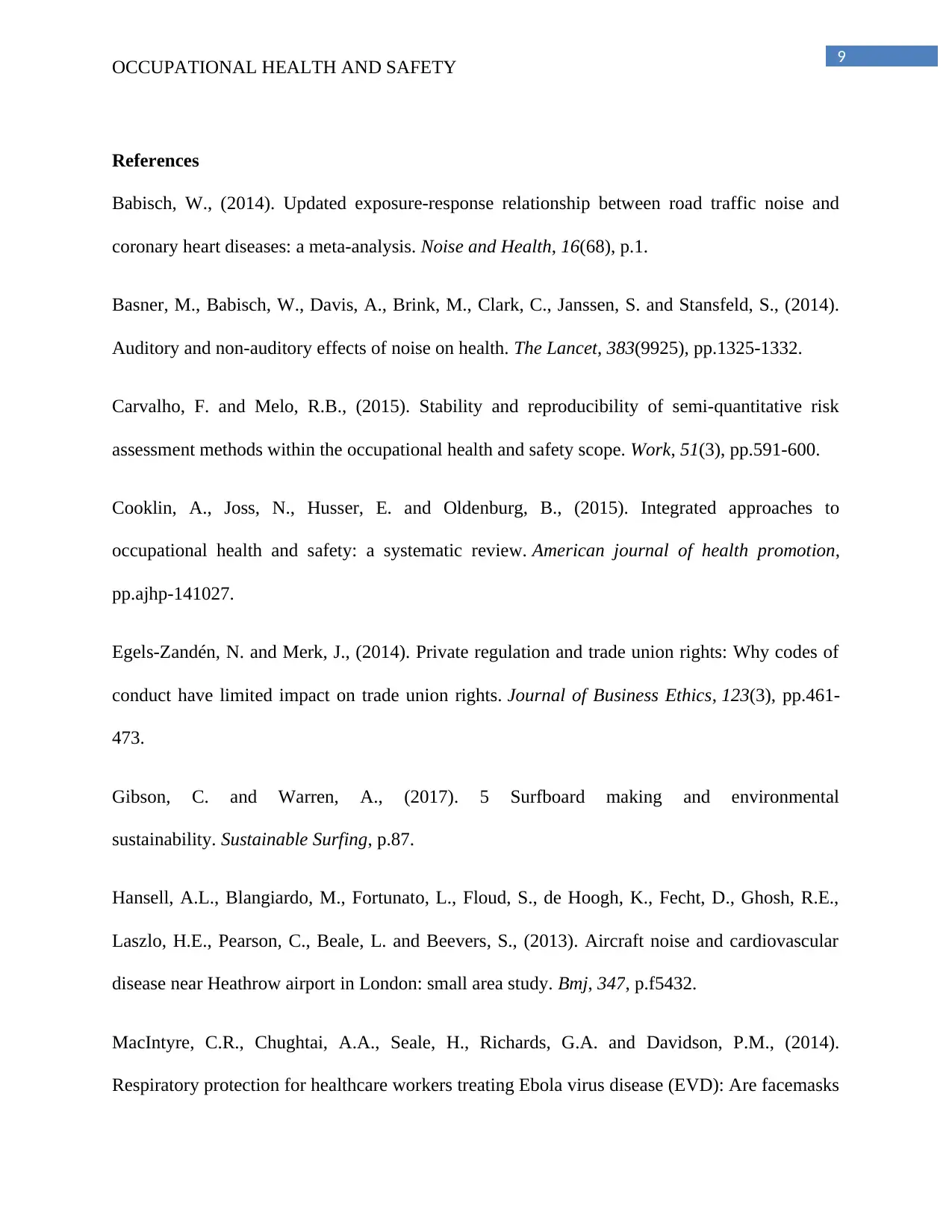
9
OCCUPATIONAL HEALTH AND SAFETY
References
Babisch, W., (2014). Updated exposure-response relationship between road traffic noise and
coronary heart diseases: a meta-analysis. Noise and Health, 16(68), p.1.
Basner, M., Babisch, W., Davis, A., Brink, M., Clark, C., Janssen, S. and Stansfeld, S., (2014).
Auditory and non-auditory effects of noise on health. The Lancet, 383(9925), pp.1325-1332.
Carvalho, F. and Melo, R.B., (2015). Stability and reproducibility of semi-quantitative risk
assessment methods within the occupational health and safety scope. Work, 51(3), pp.591-600.
Cooklin, A., Joss, N., Husser, E. and Oldenburg, B., (2015). Integrated approaches to
occupational health and safety: a systematic review. American journal of health promotion,
pp.ajhp-141027.
Egels-Zandén, N. and Merk, J., (2014). Private regulation and trade union rights: Why codes of
conduct have limited impact on trade union rights. Journal of Business Ethics, 123(3), pp.461-
473.
Gibson, C. and Warren, A., (2017). 5 Surfboard making and environmental
sustainability. Sustainable Surfing, p.87.
Hansell, A.L., Blangiardo, M., Fortunato, L., Floud, S., de Hoogh, K., Fecht, D., Ghosh, R.E.,
Laszlo, H.E., Pearson, C., Beale, L. and Beevers, S., (2013). Aircraft noise and cardiovascular
disease near Heathrow airport in London: small area study. Bmj, 347, p.f5432.
MacIntyre, C.R., Chughtai, A.A., Seale, H., Richards, G.A. and Davidson, P.M., (2014).
Respiratory protection for healthcare workers treating Ebola virus disease (EVD): Are facemasks
OCCUPATIONAL HEALTH AND SAFETY
References
Babisch, W., (2014). Updated exposure-response relationship between road traffic noise and
coronary heart diseases: a meta-analysis. Noise and Health, 16(68), p.1.
Basner, M., Babisch, W., Davis, A., Brink, M., Clark, C., Janssen, S. and Stansfeld, S., (2014).
Auditory and non-auditory effects of noise on health. The Lancet, 383(9925), pp.1325-1332.
Carvalho, F. and Melo, R.B., (2015). Stability and reproducibility of semi-quantitative risk
assessment methods within the occupational health and safety scope. Work, 51(3), pp.591-600.
Cooklin, A., Joss, N., Husser, E. and Oldenburg, B., (2015). Integrated approaches to
occupational health and safety: a systematic review. American journal of health promotion,
pp.ajhp-141027.
Egels-Zandén, N. and Merk, J., (2014). Private regulation and trade union rights: Why codes of
conduct have limited impact on trade union rights. Journal of Business Ethics, 123(3), pp.461-
473.
Gibson, C. and Warren, A., (2017). 5 Surfboard making and environmental
sustainability. Sustainable Surfing, p.87.
Hansell, A.L., Blangiardo, M., Fortunato, L., Floud, S., de Hoogh, K., Fecht, D., Ghosh, R.E.,
Laszlo, H.E., Pearson, C., Beale, L. and Beevers, S., (2013). Aircraft noise and cardiovascular
disease near Heathrow airport in London: small area study. Bmj, 347, p.f5432.
MacIntyre, C.R., Chughtai, A.A., Seale, H., Richards, G.A. and Davidson, P.M., (2014).
Respiratory protection for healthcare workers treating Ebola virus disease (EVD): Are facemasks
Paraphrase This Document
Need a fresh take? Get an instant paraphrase of this document with our AI Paraphraser
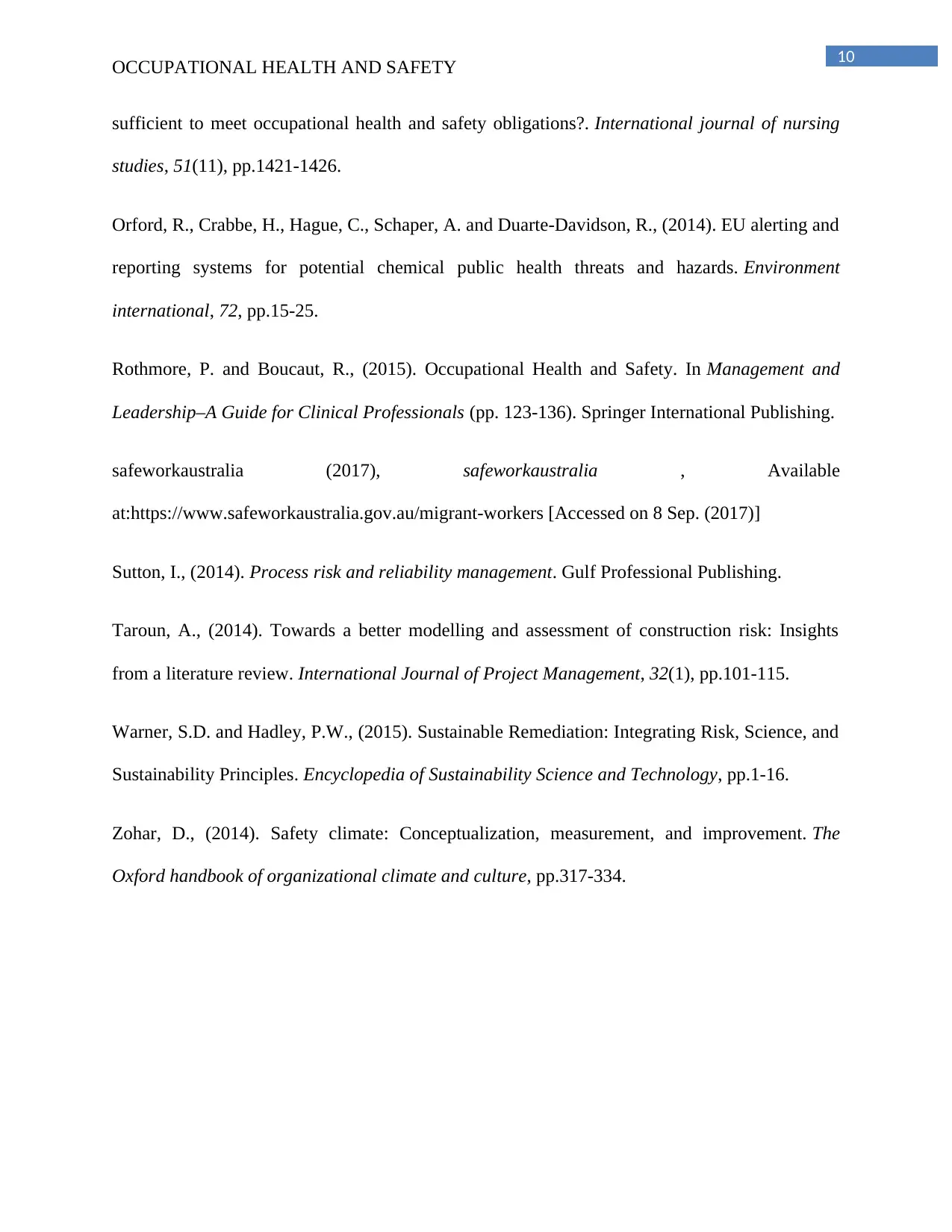
10
OCCUPATIONAL HEALTH AND SAFETY
sufficient to meet occupational health and safety obligations?. International journal of nursing
studies, 51(11), pp.1421-1426.
Orford, R., Crabbe, H., Hague, C., Schaper, A. and Duarte-Davidson, R., (2014). EU alerting and
reporting systems for potential chemical public health threats and hazards. Environment
international, 72, pp.15-25.
Rothmore, P. and Boucaut, R., (2015). Occupational Health and Safety. In Management and
Leadership–A Guide for Clinical Professionals (pp. 123-136). Springer International Publishing.
safeworkaustralia (2017), safeworkaustralia , Available
at:https://www.safeworkaustralia.gov.au/migrant-workers [Accessed on 8 Sep. (2017)]
Sutton, I., (2014). Process risk and reliability management. Gulf Professional Publishing.
Taroun, A., (2014). Towards a better modelling and assessment of construction risk: Insights
from a literature review. International Journal of Project Management, 32(1), pp.101-115.
Warner, S.D. and Hadley, P.W., (2015). Sustainable Remediation: Integrating Risk, Science, and
Sustainability Principles. Encyclopedia of Sustainability Science and Technology, pp.1-16.
Zohar, D., (2014). Safety climate: Conceptualization, measurement, and improvement. The
Oxford handbook of organizational climate and culture, pp.317-334.
OCCUPATIONAL HEALTH AND SAFETY
sufficient to meet occupational health and safety obligations?. International journal of nursing
studies, 51(11), pp.1421-1426.
Orford, R., Crabbe, H., Hague, C., Schaper, A. and Duarte-Davidson, R., (2014). EU alerting and
reporting systems for potential chemical public health threats and hazards. Environment
international, 72, pp.15-25.
Rothmore, P. and Boucaut, R., (2015). Occupational Health and Safety. In Management and
Leadership–A Guide for Clinical Professionals (pp. 123-136). Springer International Publishing.
safeworkaustralia (2017), safeworkaustralia , Available
at:https://www.safeworkaustralia.gov.au/migrant-workers [Accessed on 8 Sep. (2017)]
Sutton, I., (2014). Process risk and reliability management. Gulf Professional Publishing.
Taroun, A., (2014). Towards a better modelling and assessment of construction risk: Insights
from a literature review. International Journal of Project Management, 32(1), pp.101-115.
Warner, S.D. and Hadley, P.W., (2015). Sustainable Remediation: Integrating Risk, Science, and
Sustainability Principles. Encyclopedia of Sustainability Science and Technology, pp.1-16.
Zohar, D., (2014). Safety climate: Conceptualization, measurement, and improvement. The
Oxford handbook of organizational climate and culture, pp.317-334.
1 out of 11
Related Documents
Your All-in-One AI-Powered Toolkit for Academic Success.
+13062052269
info@desklib.com
Available 24*7 on WhatsApp / Email
![[object Object]](/_next/static/media/star-bottom.7253800d.svg)
Unlock your academic potential
Copyright © 2020–2025 A2Z Services. All Rights Reserved. Developed and managed by ZUCOL.




